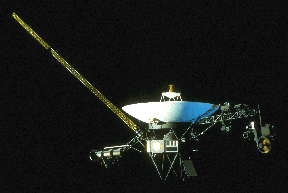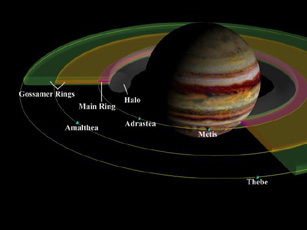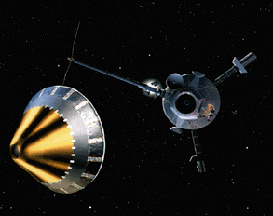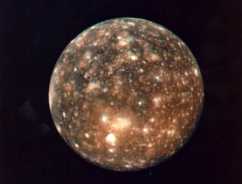This diagram shows the innermost moons of Jupiter, including Adrastea, as well as Jupiter's system of rings.
Click on image for full size
Image courtesy of NASA/JPL.
Adrastea
Adrastea is a small moon of Jupiter. Of Jupiter's 60 moons, it is the second closest to the planet. Adrastea was discovered by David Jewitt and Ed Danielson of the Voyager team in 1979.
Adrastea is tiny and not quite round. It measures 13 x 10 x 8 km (8 x 6 x 5 miles). It orbits Jupiter at a distance of 128,971 km (about 80 thousand miles) from the planet's center.
Adrastea and another nearby moon, Metis, orbit within Jupiter's main ring. The Galileo spacecraft discovered that dust knocked from the surface of these two moons by asteroid impacts generates the material that makes up the main ring!
In Roman mythology, Adrastea was the daughter of Jupiter and Ananke and the distributor of rewards and punishments.
You might also be interested in:

The rare arrangement of planets Jupiter, Saturn, Uranus, and Neptune in the 1980's made it possible for the Voyager spacecrafts to visit them over a 12 year span instead of the normal 30. They used gravity
...more
Jupiter has a series of rings circling it! Unlike Saturn's rings, which are clearly visible from Earth even through small telescopes, Jupiter's rings are very difficult to see. So difficult, in fact, that
...more
The Galileo spacecraft was launched on October 19, 1989. Galileo had two parts: an orbiter and a descent probe that parachuted into Jupiter's atmosphere. Galileo's main mission was to explore Jupiter and
...more
Scientists recently discovered the origin of Jupiter's rings. With the help of the Galileo spacecraft, scientists figured out that the rings are made from dust that was kicked off of the small moons surrounding
...more
In Roman mythology, Jupiter (Zeus in Greek mythology) was the king of heaven and Earth and of all the Olympian gods. He was also known as the god of justice. He was named king of the gods in the special
...more
Amalthea was discovered by E Barnard in 1872. Of the 17 moons it is the 3rd closest to Jupiter, with a standoff distance of 181,300 km. Amalthea is about the size of a county or small state, and is just
...more
Callisto was first discovered by Galileo in 1610, making it one of the Galilean Satellites. Of the 60 moons it is the 8th closest to Jupiter, with a standoff distance of 1,070,000 km. It is the 2nd largest
...more













